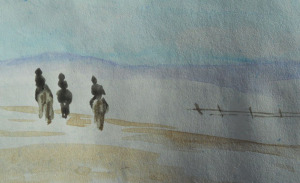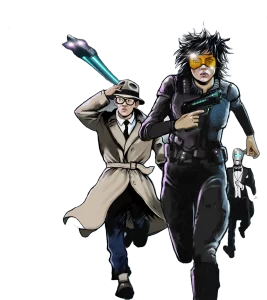 My last day in the camp and we are invited to visit the nomadic home of Bachka who lives nearby (at least he does at the moment). Bachka is the local horse master, I have seen him in action taking tourists for horse rides across the plain. In minus 20 degrees he wears no gloves or scarf, just a traditional Mongolian hat, smock and boots (the boots, by the way are sported by all the serious horsemen; they are tall, heavy wrappings of leather and sheepskin and look like they eat Uggs for breakfast). When the tourist groups return from the ride, frozen to the core and desperate to get inside, he cheerfully spends another hour outside tending to his animals; Bachka is made of seriously stern stuff.
My last day in the camp and we are invited to visit the nomadic home of Bachka who lives nearby (at least he does at the moment). Bachka is the local horse master, I have seen him in action taking tourists for horse rides across the plain. In minus 20 degrees he wears no gloves or scarf, just a traditional Mongolian hat, smock and boots (the boots, by the way are sported by all the serious horsemen; they are tall, heavy wrappings of leather and sheepskin and look like they eat Uggs for breakfast). When the tourist groups return from the ride, frozen to the core and desperate to get inside, he cheerfully spends another hour outside tending to his animals; Bachka is made of seriously stern stuff.
For the horse master, tourist excursions provide some ready income but the serious business for him is to compete in the horse racing which is a hugely important sport here. Prizes can be very large, including cars and even apartments. Outside Bachka’s house there is a brand new motorbike; it looks like it has been regularly polished although I have only ever seen him ride a horse.
He welcomes us into his ger and serves us salted, milk tea and pastries. We sit in a slightly awkward silence with our tour guide and I have an uncomfortable sense of having been brought to ‘visit the natives’ – I feel like the Duchess of Kent. I take out a small conjuring trick I have brought with me to break the ice and ask if he would like to see it. He watches me perform it in absolute silence and then asks to see it again. Again silence; Bachka is a tough crowd. Then suddenly he roars with laughter and gives me a big thumbs up – his smile lights up the room; it is a very genuine moment.
Outside we inspect his horses. My knowledge of horses roughly extends to identifying which end the food goes in and which end to stand clear of. However even to my untrained eye these are very well cared for animals. In the summer they feed off the rich grasslands but in the long winter Bachka has to buy in additional oats and grass from his meagre income. His life seems incredibly hard in ways I can only begin to imagine and yet he seems very warm, open and, well, happy.
On the way back to town we visit the newly opened Chingiss Khan statue; a 40 metre high stainless steel monument facing out over the plains. There is a museum attached with the history of Chingiss’s life and his influence on the development of Mongolia. I can’t find any mention of the 40 million people who died in the Mongol rampage across Asia and Europe (and this was back in the C13th when 40m was a lot of people) and I suspect that Chingiss has now transcended history in much the same way as King Arthur, Boudicca and Joan of Arc.
Back in town I take the time to do a little souvenir shopping. Modern Mongolians have substituted their horses for Toyotas and Mazdas which they drive with merciless zeal and anyone on foot is given no quarter. There are no lights, no traffic islands and no pedestrian crossings (well there are, but I think they are just meant to give drivers something to aim at). I find myself close to a panic attack as Nasaa weaves across the street, facing down advancing 4x4s like a matador.
 The shops are full of international luxury brands and the bars are full of British, Russian and Chinese engineers and mining company workers. Out on the street care must be taken to avoid the pickpockets and bag slitters. Some of the young men on the street are openly hostile; they seem neither warm, open nor happy. Although we have only moved a few miles it feels like we have already travelled a long way from the disciplines and traditions of the horse master.
The shops are full of international luxury brands and the bars are full of British, Russian and Chinese engineers and mining company workers. Out on the street care must be taken to avoid the pickpockets and bag slitters. Some of the young men on the street are openly hostile; they seem neither warm, open nor happy. Although we have only moved a few miles it feels like we have already travelled a long way from the disciplines and traditions of the horse master.




